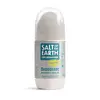Salt Of The Earth Natural Roll-On Deodorant Versus Dove Clinical Protection Antiperspirant Deodorant Stick
What's inside
What's inside
 Key Ingredients
Key Ingredients

 Benefits
Benefits

 Concerns
Concerns

 Ingredients Side-by-side
Ingredients Side-by-side

Water
Skin ConditioningPotassium Alum
AstringentTriethyl Citrate
MaskingSodium Lactate
BufferingMagnesium Chloride
Aloe Barbadensis Leaf Juice Powder
Skin ConditioningRosmarinus Officinalis Leaf Extract
AntimicrobialHelianthus Annuus Seed Oil
EmollientDecyl Glucoside
CleansingXanthan Gum
EmulsifyingXylityl Sesquicaprylate
AntimicrobialMagnesium Hydroxide
AbsorbentMagnesium Carbonate Hydroxide
BufferingSodium Anisate
AntimicrobialPhytic Acid
Water, Potassium Alum, Triethyl Citrate, Sodium Lactate, Magnesium Chloride, Aloe Barbadensis Leaf Juice Powder, Rosmarinus Officinalis Leaf Extract, Helianthus Annuus Seed Oil, Decyl Glucoside, Xanthan Gum, Xylityl Sesquicaprylate, Magnesium Hydroxide, Magnesium Carbonate Hydroxide, Sodium Anisate, Phytic Acid
Ingredients Explained
These ingredients are found in both products.
Ingredients higher up in an ingredient list are typically present in a larger amount.
Helianthus Annuus Seed Oil is the oil derived from the seeds of a Sunflower. Sunflower seed oil is non-fragrant. It is an emollient, meaning it helps to soften the skin.
Sunflower seed oil contains many fatty acids. The fatty acids found in sunflower seeds include (from highest amount to least): linoleic acid, myristic acid, palmitic acid, stearic acid, arachidic acid, oleic acid, and linolenic acid.
These fatty acids help the skin create ceramides. Ceramides play a role in repairing the skin barrier.
Helianthus Annuus Seed Oil helps moisturize the skin. This in turn helps the skin look more rejuvenated and smoother.
Sunflowers are rich in vitamin E.
Historians believe Indigenous cultures of North America domesticated sunflowers before corn. Thus they relied on sunflower oil for a variety of uses. One such use is moisturizing skin and hair.
Sunflower seed oil may not be fungal acne safe. We recommend speaking with a professional if you have any concerns.
Learn more about Helianthus Annuus Seed Oil